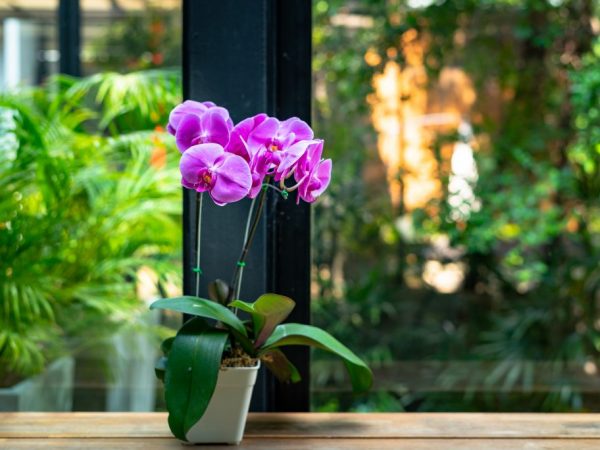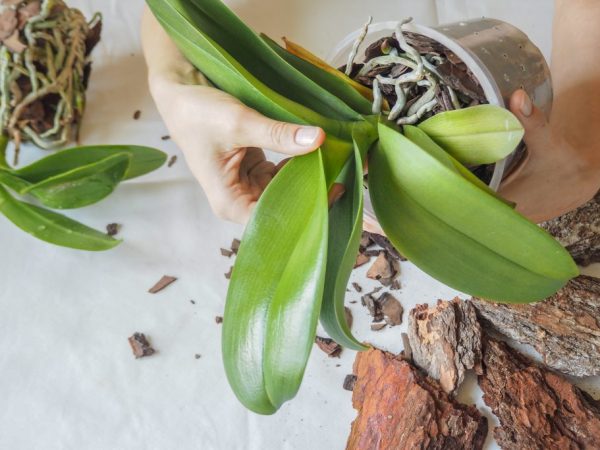Home care for phalaenopsis after purchase
Proper care of phalaenopsis after purchase plays an important role, because it depends on him whether it will take root in a flower in new conditions and whether it will bloom.

Home care for phalaenopsis after purchase
Flower adaptation
After the purchase, the flower needs an adaptation period. This is due to the fact that a special microclimate was created for the plant in store conditions, significantly different from the home one.
When moving to home conditions, the microclimate changes abruptly, including:
- the temperature regime is different;
- humidity decreases or increases;
- the illumination changes.
All these changes affect the flower, and it takes time for the plant to adapt to the new microclimate.
For the period of adaptation, phalaenopsis often drops buds and already blossoming inflorescences, the foliage turns yellow, withers and dries.
To speed up adaptation, it is recommended to create a quarantine for phalaenopsis after purchase, placing it away from other indoor plants. This will protect the rest of the home flowers from possible pests and diseases. The duration of the adaptation period is 3 weeks.
Initial measures
Immediately after the purchase of phalaenopsis, he is looked after, starting with the adoption of a number of measures, including:
- examination for the presence of pests and diseases, if symptoms are detected, treatment should be started 2 weeks later, during which the plant can grow stronger in a new environment;
- analysis of the upper layer of the bark for the presence of a white poisonous plaque on it; if it is found, the affected bark is thrown away.
During the examination, the plants do not immediately cut off the wilted and yellowed foliage, because it can recover during the adaptation period. Immediately after purchase, the flower is watered no more than once every 7 days, fertilizing complexes and growth-stimulating drugs are not used.
Is it worth replanting
A flower transplant is necessary if:
- the plant is planted in an unsuitable substrate, which does not allow the phalaenopsis to provide the required moisture and air supply to the roots;
- the flower is in a ceramic pot container without drainage and holes in the bottom, it is difficult to determine the degree of drying of the substrate and the need for watering through the opaque ceramic of the pot;
- a lump of sphagnum is placed in a potted container directly under the roots, which acts as a growth stimulant and retains moisture; when the microclimate changes, it often provokes rotting of the roots and the lower part of the stem;
- the pot container is small and turns over under the weight of the flower, and the roots have almost completely displaced the substrate;
- the roots dried up or, on the contrary, softened and began to rot.
A transplant harms the phalaenopsis if:
- carried out at the flowering stage,
- the plant has a healthy appearance, including firm green foliage, no black specks, aerial roots without damage and rot.
For a healthy flower, the transplant is postponed until the green tips appear on the root system, which means the end of the adaptation period in Phalaenopsis and the beginning of active growth under new conditions.
Transplant procedure

When transplanting, try not to damage the root system.
If phalaenopsis still needs to be transplanted after purchase, then a transparent potted container is selected, the size of which is 2-3 cm larger than the previous one. The optimal substrate for phalaenopsis is a mixture of dry bark from pine or pine.
Transplant instructions:
- get a flower, having previously kneaded the substrate in it,
- soak the orchid together with the rest of the soil in warm water for 1 hour,
- rinse off the remnant of the old substrate under running water,
- examine the root system for rotten and dead parts, while the dead roots, when pressed on them, moisture appears,
- cut places of cuts with charcoal or cinnamon powder,
- leave the orchid to dry,
- pour a drainage mixture of expanded clay or river sand on the bottom of the pot, place the flower in the center and cover it with soil,
- equip a peduncle support.
After transplanting phalaenopsis, watering is stopped for several days.
Microclimate creation
The creation of a microclimate during the care process involves the correct illumination, regular watering and maintaining the required air temperature.
Lighting
Immediately after the purchase, phalaenopsis is protected from bright light by choosing a place in partial shade, but protected from drafts. At the end of the adaptation period, a window sill on the western or eastern side of the room is a suitable place for a flower.
Temperature
The temperature regime is immediately set at 30-32 ° C in the summer, 15-17 ° C in the winter.
Watering
The humidity for the orchid in the first days is maintained at a level of 40-60%, increasing after adaptation to 70-80%. Freshly bought orchid is not sprayed. To create optimal humidity, the pot container is placed on a pallet with moistened pebbles or gravel.
Immediately after purchase, for up to 10 days, the plant is not watered, so as not to lead to overflow, from which the orchid dies. Subsequently, they take care of the orchid, pouring it with warm soft water and soaking the flower in it for half an hour. An overdried flower will fully recover after the first watering.
Conclusion
If you properly care for phalaenopsis after buying it in the store, it is possible to ensure the subsequent growth and development of the plant. At the initial adaptation stage in the care process, it is important to create a suitable microclimate and not cause additional stress to the plant, protecting it from unnecessary manipulations.


